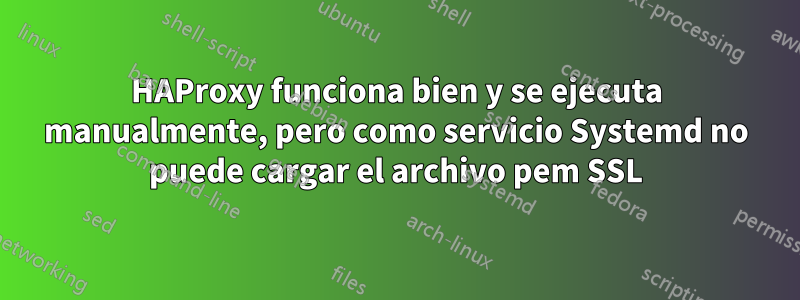
Estoy intentando configurar SSL en un servidor Fedora 22 que ejecuta HAProxy. Aquí está la configuración ( /etc/haproxy/haproxy.cfg):
global
log 127.0.0.1 local2
chroot /var/lib/haproxy
pidfile /var/run/haproxy.pid
maxconn 4000
user haproxy
group haproxy
daemon
tune.ssl.default-dh-param 2048
defaults
log global
mode http
option httplog
option dontlognull
option http-server-close
option forwardfor
option redispatch
retries 3
timeout http-request 10s
timeout queue 1m
timeout connect 10s
timeout client 1m
timeout server 1m
timeout http-keep-alive 10s
timeout check 10s
frontend main
bind *:80
bind *:443 ssl crt /etc/haproxy/certificate.pem
redirect scheme https if !{ ssl_fc }
default_backend app
backend app
balance roundrobin
server app1 127.0.0.1:8000 check
Ahora, cuando ejecuto systemctl restart haproxy && journalctl -u haproxy.service -f, aparece este error:
Sep 13 15:39:31 fedora-server systemd[1]: Started HAProxy Load Balancer.
Sep 13 15:39:31 fedora-server systemd[1]: Starting HAProxy Load Balancer...
Sep 13 15:39:31 fedora-server haproxy-systemd-wrapper[15620]: haproxy-systemd-wrapper: executing /usr/sbin/haproxy -f /etc/haproxy/haproxy.cfg -p /run/haproxy.pid -Ds
Sep 13 15:39:31 fedora-server haproxy-systemd-wrapper[15620]: [ALERT] 255/153931 (15621) : parsing [/etc/haproxy/haproxy.cfg:30] : 'bind *:443' : unable to load SSL private key from PEM file '/etc/haproxy/certificate.pem'.
Sep 13 15:39:31 fedora-server haproxy-systemd-wrapper[15620]: [ALERT] 255/153931 (15621) : Error(s) found in configuration file : /etc/haproxy/haproxy.cfg
Sep 13 15:39:31 fedora-server haproxy-systemd-wrapper[15620]: [ALERT] 255/153931 (15621) : Proxy 'main': no SSL certificate specified for bind '*:443' at [/etc/haproxy/haproxy.cfg:30] (use 'crt').
Sep 13 15:39:31 fedora-server haproxy-systemd-wrapper[15620]: [ALERT] 255/153931 (15621) : Fatal errors found in configuration.
Sep 13 15:39:31 fedora-server haproxy-systemd-wrapper[15620]: haproxy-systemd-wrapper: exit, haproxy RC=256
Aquí está la configuración del servicio:
# cat /usr/lib/systemd/system/haproxy.service
[Unit]
Description=HAProxy Load Balancer
After=syslog.target network.target
[Service]
EnvironmentFile=/etc/sysconfig/haproxy
ExecStart=/usr/sbin/haproxy-systemd-wrapper -f /etc/haproxy/haproxy.cfg -p /run/haproxy.pid $OPTIONS
ExecReload=/bin/kill -USR2 $MAINPID
[Install]
WantedBy=multi-user.target
Sin embargo, puedo copiar el comando que el servicio intenta ejecutar y funciona bien.
Primero, esto funciona cuando lo ejecuto manualmente (tomado de la configuración del servicio):
# whoami
root
# /usr/sbin/haproxy-systemd-wrapper -f /etc/haproxy/haproxy.cfg -p /run/haproxy.pid
Esto también funciona (tomado de los registros de servicio, aparentemente haproxy-systemd-wrapperejecuta esto:
# whoami
root
# /usr/sbin/haproxy -f /etc/haproxy/haproxy.cfg -p /run/haproxy.pid -Ds
Para aclarar: cuando ejecuto cualquiera de estos comandos manualmente como root, funcionan y puedo acceder a mi sitio a través de SSL.
Entonces, supongo que cuando se ejecuta como servicio, HAProxy no puede leer el certificado.
Esto es lo que he probado hasta ahora:
chown haproxy:haproxy /etc/haproxy/certificate.pem- Cambiar de usuario y grupo a root
haproxy.cfg - Agregar
User=rootyGroup=rootconfigurar el servicio en[Service] sudo -u haproxy /usr/sbin/haproxy -f /etc/haproxy/haproxy.cfg -p /run/haproxy.pid -Dsda un error diferente (con respecto a los puertos), por lo que lo más probable es que el servicio no utilice el usuario haproxy; de lo contrario, llegaría más lejos
Puedo acceder al archivo como usuario haproxy, sudo -u haproxy cat /etc/haproxy/certificate.pem.
Editar:
Aquí está la configuración del servicio actualizada según su respuesta:
[Unit]
Description=HAProxy Load Balancer
After=syslog.target network.target
SELinuxContext=unconfined_u:object_r:var_t:s0
Que pasa ahora:
Sep 13 17:51:21 ServiceName systemd[1]: Starting HAProxy Load Balancer...
Sep 13 17:51:21 ServiceName systemd[1]: haproxy.service: main process exited, code=exited, status=203/EXEC
Sep 13 17:51:21 ServiceName systemd[1]: Unit haproxy.service entered failed state.
Sep 13 17:51:21 ServiceName systemd[1]: haproxy.service failed.
Cómo obtuve el valor de SELinuxContext:
# ls -lZ /etc/haproxy/certificate.pem
-rw-r--r--. 1 root root unconfined_u:object_r:var_t:s0 9245 Sep 13 17:43 /etc/haproxy/certificate.pem
Respuesta1
Estás en Fedora, que usaSELinux. Los servicios de Systemd se ejecutan en un entorno limpio: sonnogenerado por systemctl directamente, por lo que, entre otras cosas, comienzan en un contexto SELinux diferente (creo que el valor predeterminado es system_u:system_r:init_t:s0?).
Asegúrese de que esté configurado el contexto SELinux correcto, tanto para el archivo de certificado (usando ls -lZy chcon) como para el proceso haproxy (posiblemente usando SELinuxContext=en la unidad systemd).
Intente ejecutar idpara ver su contexto actual (o el del servicio).


